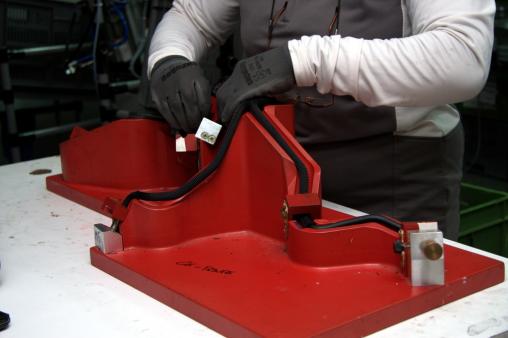Frieze Focus Interview: The image of work and the relation between art and labour
Retrieved from: https://frieze.com/article/focus-iratxe-jaio-klaas-van-gorkum in May 2014
Max Andrews I’d like to talk about your current project, provisionally titled Work in Progress, set in the Lea-Artibai district of the Basque Country where Iratxe grew up. It began with your curiosity about the informal factories in the area where women trim moulded rubber parts destined for the car industry. What drew you to this subject?
Iratxe Jaio & Klaas van Gorkum When we encountered these groups of women sitting in a circle in their makeshift workspaces, surrounded by crates and boxes, performing tedious repetitive tasks together, it struck us as an incredibly complex and layered image. Although it echoed a traditional and communal way of life in what is still a mainly rural area, instead of spinning wool or mending fishing nets these women were working with abstract industrial forms which had no direct use-value to them. A closer inspection of the pieces revealed the brand names of multinational corporations such as Renault, Mercedes and Volkswagen. The women are from countries like Moldova, Peru or Senegal, yet it’s a scene that is at once domestic, local and Basque, while being replete with the contradictions of global capitalism.
MA You are dealing with a representation of working, while also interweaving your own labour by making a film.
IJ & KvG We have a long-standing interest in the image of ‘work’, and in the relation between art and labour. So we took this scene as the starting point for a cinematic analysis of production processes, both in these semi-clandestine workshops as well as in the main factory itself. Our approach has been strictly dispassionate, free from any superficial attempt to give the workers a voice. Instead, we focused our camera on the disciplinary conditions and rationalization of these processes, reproducing them in the montage by breaking up complex scenes into smaller units and stitching them back together again.
MA How has Jorge Oteiza’s Laboratorio de Tizas (Chalk Laboratory, c.1972–4) – thousands of small sculpture-studies made by the late Basque sculptor, yet never conceived as art works per se – come to play a key role in the project?
IJ & KvG To extend the analogy between editing a movie and working on an assembly line, we wanted to ‘splice’ ourselves into the relations of production at the factory by inventing an artistic task that resembled the one already being performed by the workers. So we hired the factory workers to make synthetic resin casts of Oteiza’s ‘Tizas’. Turning Oteiza’s experimental sculpture laboratory into a mass-production line, and recording it on camera is, in essence, a formal exercise that juxtaposes the production of Modernist sculpture with industrial manufacturing. It also allowed us to stage an image of the artist at work, and to superimpose it onto that of the wage-worker, ultimately presenting both as ideologically loaded social constructions.
MA Is this project also a way for you to obliquely address the idea of Basque sculpture, from Oteiza and Eduardo Chillida through to Ibon Aranberri or Asier Mendizabal, for example?
IJ & KvG The legacy of Basque Modernism loomed over this project long before we decided explicitly to include a reference to the work of Oteiza – although, in hindsight, it seems inevitable. But to speak of ‘Basque sculpture’ is to turn it into a closed-off category. We prefer to consider how the political function and significance that was once attributed to the language of abstract sculpture in Basque society holds up under contemporary conditions.
MA In combining a study of the serial production of art with a social investigation into industrial manufacturing, you’re also reflecting on yourselves as cultural labourers. This was an important motif in your 2011 work Producing time in between other things (a project I co-curated with Mariana Cánepa Luna). Do you find it hard to be artists who make objects?
IJ & KvG Oteiza once said that it wasn’t he who made the sculptures, but that the sculptures made him a sculptor. And now that he is a sculptor, why should he create more? In a way, we have been travelling in the opposite direction. We’ve always referred to ourselves as artists who do not make objects, and we only started making things to be able to address the notion of practice itself. In Producing time in between other things, for example, the 50 ornamental wooden legs we manufactured were simply a by-product of the task we had set ourselves: to learn how to use the woodturning lathe left by Klaas’s late grandfather, a retired factory worker. We took his place behind the machine, and recorded our activities on camera, not just as a ‘measurement’ of the passage of time required to gain a certain skill, but also as a reflection on how the disciplinary conditions of the wage-worker’s spare time inform our notion of artistic freedom and vice versa. Yet we’re also very much indebted to those thousands of ‘How to ...’ videos on YouTube, from cooking a steak to casting polyurethane action figures. Considering the generosity of all that is being shared between the producers and the viewers of these videos, is it any wonder that actually eating the steak doesn’t even enter into the picture?
Iratxe Jaio and Klaas van Gorkum live in Rotterdam, the Netherlands, and have been working together since 2001. They recently completed a residency at LIPAC, Buenos Aires, Argentina. They will present a solo exhibition at FRAC Aquitaine, Bordeaux, France, opening on 4 October.
Max Andrews







![Gaur [sic]](http://www.parallelports.org/sites/parallelports.org/files/styles/small_cropped/public/field/image/article/gaursic_montajea.jpg?itok=6czeeiAF)







